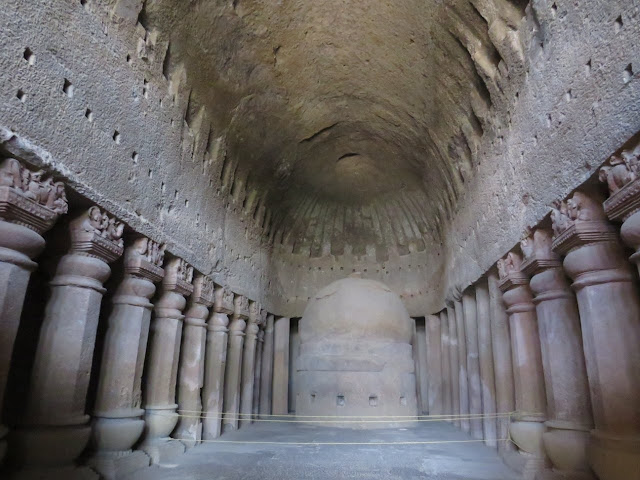Kanheri Caves - Part 15
I have been documenting the Kanheri Caves through a series of detailed articles. In earlier parts, I explored the architectural layout and sculptural grandeur of Cave No. 3, covering its majestic entrance, the imposing pillars within the Chaitya hall, colossal Buddha images, donor couple sculptures, extensive sculptural panels along the verandah walls, the central stupa, lion-crowned pillars, votive stupas, some of the earliest Buddha figures and started explaining the inscriptions found in the site.
This is the 15th article in the series. In this part, I continue focusing on the inscriptions found in and around Cave No. 3, which add another layer of depth to our understanding of the site’s history, patronage, and Buddhist affiliations.
Inscription 6
This inscription is engraved on a small bas-relief stupa located on the right side wall outside the verandah of Chaitya Cave No. 3. The votive stupa itself is modest in scale and carved directly on the rock surface.
Characters: Brahmi script, 5nd century CE
Language: Sanskrit
Content:
The text reads:
“Ye dharmā hetu-prabhavā
teṣāṁ tathāgato hyavadat
teṣāṁ ca yo nirodha
evaṁvādī mahāśramaṇaḥ.”
This is the well-known Buddhist canonical verse, often called the Pratītyasamutpāda-gāthā or the “Ye Dharma” stanza. It translates to "All things arise from a cause; their cause was explained by the Tathagata...".
This brief yet profound verse summarizes the essence of the Buddhist doctrine of dependent origination (pratītyasamutpāda). Its appearance at this location, not on a stupa within the cave but rather on a modest votive stupa outside, indicates the deep ritual and devotional importance accorded to even the smaller architectural elements in the complex.
The verse is also significant as it ties Cave No. 3 to the broader Mahayana tradition and demonstrates the role of formulaic inscriptions in sanctifying sacred space. Its presence here may also suggest the use of these votive stupas by visiting monks or lay devotees, who recited or meditated upon these lines during circumambulation or worship.
Inscription 7
This inscription is found painted in white pigment on the surface of an octagonal column within Cave No. 3. Unlike the earlier engraved epigraphs, this record is not incised but applied with pigment, offering an interesting contrast in inscriptional technique.
Characters: Proto Nagari script, 10th century CE
Language: Prakrit
Content:
It reads "In Samvat 921, on the 7th day of the bright half of the month of Ashvina." Although the rest of the content remains obscure or faded, this brief record functions primarily as a dated inscription, confirming continued activity or visitation in the cave nearly eight centuries after its excavation.
Notably, a similar inscription exists on the adjacent face of the same column. Two more appear on the opposite pillar, though they are unfortunately no longer legible. These traces point to the longevity of Kanheri as a sacred site, where pilgrims or monks left their marks centuries after the site's initial use during the Satavahana and early post-Satavahana periods.
The use of white paint and the Proto-Nagari script reflects evolving religious practices and epigraphic conventions at Kanheri. Even in this late phase, Cave No. 3 continued to resonate with sacred significance.
Inscription 8
This short inscription, consisting of three lines, was once engraved on a square stone. It was reportedly found on the terrace in front of Cave No. 3, beneath a tree. At the time of documentation, the stone was in the possession of Dr. John Wilson, a prominent scholar and missionary of 19th-century Bombay.
Characters: Brahmi script, 5th/6th century CE
Language: Prakrit
Content:
Though the exact name of the donor remains uncertain, the content clearly refers to the construction of a Chaityagriha, or shrine-house, most likely built of bricks—a somewhat rare material reference at this site, where most structures are hewn from basalt.
Although the physical inscription is now untraceable, its historical reference provides valuable insight into ancillary structures that once existed in front of the Chaitya Cave. This also suggests the expansion of the complex over time, incorporating not just rock-cut monuments but also constructed elements such as brick shrines, likely serving ritual or commemorative purposes.
Inscription 9
This brief inscription, consisting of two lines, was engraved on a small square stone found in the vicinity of Cave No. 3. Unfortunately, like the previous inscription, its current location remains unknown, and only a fragmentary reading has survived.
Characters: Brahmi script, 6th century CE
Language: Prakrit
Content:
Due to its incomplete and ambiguous content, the exact meaning and context are uncertain. The text may preserve a partial name or designation, or perhaps a reference to a donor group or artisan collective. However, without more textual context or iconographic linkage, its purpose remains speculative.
Inscription 10 - Traikutaka Copper Plate
Discovered by Dr. James Bird in 1839 in a stupa located 30–40 feet below Cave No. 3, this is a significant historical record.
Characters: Brahmi script, 494/495 CE
Language: Sanskrit
Object: Copper plate associated with funerary relics
Content:
Buddharuchi, son of Puṣyavarman and Buddhaśrī, a resident of Kanaka village in the Sindhu Viṣaya district, who served the Ten-Powered Sakya Buddha and the Śrāvaka Saradvatiputra (the chief disciple of Buddha) erected a chaitya of stone and brick intended to last eternally.
He dedicates it to Ārya Saradvatiputra, regarded as the chief disciple of Buddha, and seeks blessings from divine and semi-divine beings such as Yakṣas, Siddhas, Vidyādharas, Gandharvas, Vajrapāṇi, and others.
In poetic style, the inscription wishes for the donor’s lasting fame, comparing it to the eternal flow of rivers, the churning milky ocean, and the enduring heights of Mount Meru.
The stupa and its relics reflect continued Buddhist devotional practice, particularly the cult of relic veneration, previously reserved for the Buddha but later extended to his chief disciples, such as Sāriputra.
Happy travelling.
Bibliography - "Kanheri Inscriptions" by Shobhana Gokhale
This is Part 15 of the series of articles on Kanheri Caves. If you are interested to read the earlier parts of the series, click the links below.
.jpg)


.JPG)
Comments
Post a Comment